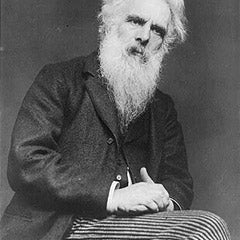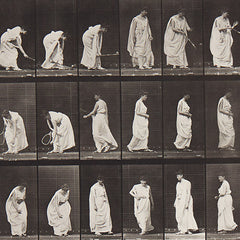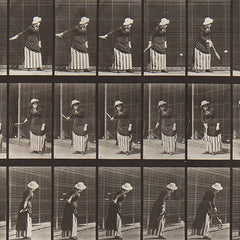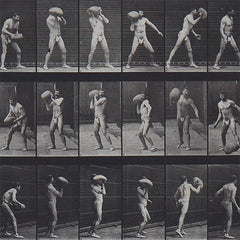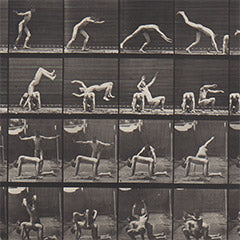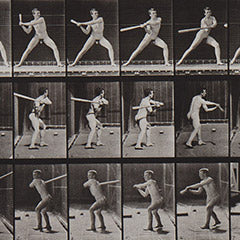Eadweard Muybridge Prints for Sale
Eadweard Muybridge (1830-1904) was born Edward Muggeridge to a merchant family in Kingston upon Thames, England. He emigrated to America, changed his name three times, came close to death and suffered brain damage in a carriage accident, and was also acquitted for the murder of his wife's lover, and the true father of his presumed son, who he later abandoned in an orphanage.
The 19th century was as hell bent on progress, invention and innovation as Muybridge, and his capacity for entrepreneurialism and progressive practice meant he invented photographic and moving image projection techniques which have helped build the motion picture industry that we know today. However, it also meant he documented some of the major events, and more subtly, the cultural and social landscape of the 19th century.
In 1855 when he first arrived in San Francisco from England, Muybridge owned a bookstore. He decided to sell the store to his brother and travel to Europe, but on his way, the stagecoach crashed, hurling Muybridge and seven other passengers into the rocky hillside. One man died and Muybridge hit his head so hard that the doctor treating him said he’d never fully recover.
Muybridge spent about six years recuperating in England, and little is known about his time there. But after his return to the US in 1866 he quickly became a masterful photographer, He captured Yosemite National Park’s thousand-foot waterfalls and its vast granite mountains––photos that would later inspire Ansel Adams.
One theory about Muybridge’s injury is that it damaged his orbitofrontal cortex, and that could explain why Muybridge became so possessed with his work and his microscopic fixation on motion to the point that his photos crossed the line into art. He photographed birds flying, cats leaping, and the American bison galloping at a time when the nation had nearly hunted the animal to extinction. His obsession with all manners of motion drove him to capture women lifting bedsheets, raising cigarettes to their lips, themes of Muybridge's photography help us to understand 19th Century life by documenting key events and ideas within it
This interested the University of Philadelphia for the potential insight it offered in the fields of sports, medicine, and physiology and it was there that Muybridge created more than 20,000 photos for his first, groundbreaking book, Animal Locomotion: an Electro-Photographic Investigation of Connective Phases of Animal Movements.
The photos were researched using banks of cameras to photograph people in a studio, and animals from the Philadelphia Zoo to study their movement. The human models, either entirely nude or very lightly clothed, were photographed against a measured grid background in a variety of action sequences, including walking up or down stairs, hammering on an anvil, carrying buckets of water, or throwing water over one another. Muybridge produced sequences showing farm, industrial, construction, and household work, military maneuvers, and everyday activities. He also photographed athletic activities such as baseball, cricket, boxing, wrestling, discus throwing, and a ballet dancer performing. Muybridge himself posed nude for some of the photographic sequences.
In 1872, the former governor of California, Leland Stanford, a businessman and race-horse owner, hired Muybridge for a portfolio depicting his mansion and other possessions, including his racehorse Occident. Stanford also wanted a proper picture of the horse at full speed and was frustrated that the existing depictions and descriptions seemed incorrect: up until this time most artists painted horses at a trot with one foot always on the ground; and at a full gallop with the front legs extended forward and the hind legs extended to the rear, and all feet off the ground. Muybridge eventually managed to shoot a small and very fuzzy picture of Occident running in 1873. They agreed it lacked quality, but Stanford was excited to finally have a reliable depiction of a rnning horse. In July 1877, Muybridge made a new picture of Occident at full speed, with improved techniques and a much clearer result. The news about this breakthrough in instantaneous photography was spread enthusiastically, but several critics believed the heavily manipulated image could not be a truthful depiction of the horse. In June 1878, Muybridge created sequential series of photographs with a battery of 12 cameras along the race track at Stanford's Palo Alto Stock Farm (now the campus of Stanford University). The shutters were automatically triggered when a horse tripped the wires connected to an electromagnetic circuit. For a session on 15 June 1878, the press and a selection of turfmen were invited to witness the process. An accident with a snapping strap was captured on the negatives and shown to the attendees, convincing even the most skeptical witnesses. The news of his success was reported worldwide.
